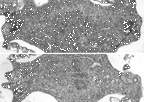Trimastix
Reproduction and life history
Trimastix cells reproduce asexually by binary fission, with
mitotic division of the nucleus.
 During late interphase, new basal
bodies form in the kinetid. At the onset of prophase, the old
microtubular roots become separated from the kinetid and eventually
disappear. The eight basal bodies separate semiconservatively (two
parental ones and two new ones in each set). Flagella remain attached to
the parental basal bodies throughout mitosis. The basal bodies migrate to
opposite ends of the cell and become the focus for the mitotic spindle
poles. During late interphase, new basal
bodies form in the kinetid. At the onset of prophase, the old
microtubular roots become separated from the kinetid and eventually
disappear. The eight basal bodies separate semiconservatively (two
parental ones and two new ones in each set). Flagella remain attached to
the parental basal bodies throughout mitosis. The basal bodies migrate to
opposite ends of the cell and become the focus for the mitotic spindle
poles. |
 The mitotic spindle consists of two cones of microtubules, one from the
vicinity of each kinetid. The microtubules of the cones extend
to the chromosomes; no microtubules, it appears, extend from spindle pole
to spindle pole (in other words, there is no "interzonal
spindle"). The nuclear envelope is not visible at metaphase
(the spindle is "open"), nor is the nucleolus visible. During
anaphase, chromosomes move to the spindle poles. As there does
not seem to be a lengthening of the distance between the poles,
chromosome movement seems to depend on a shortening of the
chromosome-to-pole microtubules.
The mitotic spindle consists of two cones of microtubules, one from the
vicinity of each kinetid. The microtubules of the cones extend
to the chromosomes; no microtubules, it appears, extend from spindle pole
to spindle pole (in other words, there is no "interzonal
spindle"). The nuclear envelope is not visible at metaphase
(the spindle is "open"), nor is the nucleolus visible. During
anaphase, chromosomes move to the spindle poles. As there does
not seem to be a lengthening of the distance between the poles,
chromosome movement seems to depend on a shortening of the
chromosome-to-pole microtubules.
New microtubular roots, and
new flagella on the younger basal bodies, begin to form during
late prophase and continue to form during the rest of cell
division, so that flagella and the interphase cytoskeleton are
fully formed by the completion of cytokinesis (cell separation).
In terms of the architecture of the mitotic spindle, and the sequence of
mitotic events, Trimastix has more in common with both
the jakobid flagellates and the retortamonads than with any
other protist group. |
Cysts form, as far as is known, from single trophic cells.
No sexual reproduction has been observed.
Return to summary information
 During late interphase, new basal
bodies form in the kinetid. At the onset of prophase, the old
microtubular roots become separated from the kinetid and eventually
disappear. The eight basal bodies separate semiconservatively (two
parental ones and two new ones in each set). Flagella remain attached to
the parental basal bodies throughout mitosis. The basal bodies migrate to
opposite ends of the cell and become the focus for the mitotic spindle
poles.
During late interphase, new basal
bodies form in the kinetid. At the onset of prophase, the old
microtubular roots become separated from the kinetid and eventually
disappear. The eight basal bodies separate semiconservatively (two
parental ones and two new ones in each set). Flagella remain attached to
the parental basal bodies throughout mitosis. The basal bodies migrate to
opposite ends of the cell and become the focus for the mitotic spindle
poles.